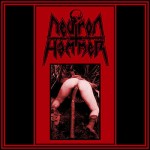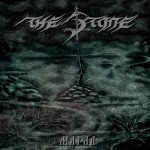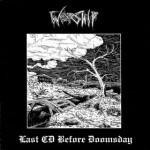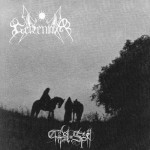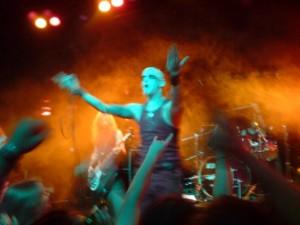Hellfires were set loose in Helsinki, Finland last weekend by a horde of black metal maniacs from all over the Earth. Profanation, an intangible feeling of myth, alignment of spirits, pervaded the atmosphere. Let me remind you that while the gig situation concerning underground black and death metal in Finland is rich and fertile, every so-called cult band appearing on stage is no longer going to change anyone’s life to something more mysterious and powerful. Maybe the younger audience sees the matter differently, but I believe they are becoming jaded also. This weekend was something different however. The main event was the 2-day Black Flames of Blasphemy fest, on 23rd and 24th, the Friday night featuring Taake and Horna, among others, but I wasn’t attending, on one hand because of a lack of interest regarding the bands, on the other because I could use one spare night between the “pre-party” on 22th (aptly called “Unholy Night to Remember”) and the Saturday explosion featuring bands of the caliber of Blasphemy and Revenge from Canada.
The dark side of Finland
So, it all started on a rainy and windy Thursday night, in a small Helsinki pub called Darkside which I had only visited once before, when it was empty. No-one was expecting a large crowd because normal people would have jobs and studies to attend to, but the place was crowded and intense. Demonos of Barathrum, the drunken bastard, was shouting at the doorman and people were consuming beer like it was the eve of ragnarók. In that one room of a few hundred cubic meters had been compressed all the dreams and neuroses of Finnish black metal since its very beginning. Even Pete Helmkamp came around to see for himself what the fuck was going on. Ofdoom, a Blasphemy clone from Hamina whose members are barely 18 years old, played a reasonably aggressive set of uncannily familiar sounding songs. I am thankful that at least the cover song choice was “Christ’s Death” by Sarcofago instead of something from the war metal scene. Many of the old school maniacs I met applauded the energy and sincerity these young guys brought to the evening. However, I was more thrilled by the Goatmoon set that saw the audience become a rioting mass of fists and headbanging. The garage punks of Finnish black metal, Goatmoon unleashed a set of familiar songs from their albums mostly resembling a triumphantly melodic cross of Dimmu Borgir demos and Absurd, not to mention an enormously provocative cover from Finnish RAC band Mistreat.
But the real reason why everybody was there that night, the crux of all the anticipation and nervous violence was the return of the infamous Azazel on stage, an early Finnish black metal coven lost to annals of history but fondly remembered by everyone who breathed the air of 90′s Finland, when worship of darkness was still pure and cold… clad in spikes. Stories about Azazel and their infamous frontman Lord Satanachia are equivalent to an inverted saga, one of madness and devotion. For a decade the band was forgotten until suddenly it seemed to have reformed in alliance with some members from young occult metal band Charnel Winds. It all seemed unbelievable and to see it with one’s own eyes… triumph!
It wasn’t a surprise to anyone that an Azazel gig might prove to be a disaster, in normal sense. Enveloped in the mists and throes of an ancient curse, the guitarist’s malfunctioning equipment threw the disorganized band from the brink of a metaphorical cliff into the abyss, to be carried upon the wings of Death. While Demonos threw himself from the audience into the stage in an alcoholic spasm, wires were torn, microphones were ripped and fists started flying. Part of the equipment was mute, the rhythm section was confused and Satanachia’s croaks were barely audible chants and incantations of demonic names. A morbid pall descended upon Helsinki. In anti-arranged structures of primitive, broken black metal, Azazel mocked everything and everyone. Brilliant and beautiful riffs, performed at variable and confused speeds, interlocked with rhythms and blasts whose randomness remained cryptically problematic. No-one knew if the songs are actually like this or have all the members gone insane. The most sensitive part of the crowd was devastated and ultimately impressed. Others were bored and drunk. Enough said about that evening except that I doubted even Saturday can give a more authentic black metal experience, because for the rest of the night and the next day, Azazel’s psychosis was still deeply within my heart.
The church of blasphemy
Saturday night was again cloaked in the weather of Jack the Ripper’s London. Through the rain we approached the ominously titled Dante’s Highlight, converted from an old church on whose steps Mannerheim and Hitler had shaken hands in a pact of war. It served as a normal nightclub until a few years ago it became one of the prominent metal bars of Helsinki. We have no knowledge how much blasphemous intent influenced its current use, but it was something to see candles and torches lighting the altar (stage), bestowing a comforting, cavernous gleam upon the high ceiling and reflecting from the chain-wrapped wooden posts adorned with gasmasks. The gig organizers par excellence Kold Reso Kvlt had taken lots of care in making this event perfect, as it was also the destination of a veritable exodus of German, French, Italian and other foreign black and death metal fans.
Proclamation from Spain launched into formally perfect, yet somehow vague and heartless Blasphemy aping primitive death metallic sounds and while the gig was technically the dream of your standard NWN forum fan, it raised apprehension that this is going to be an evening where every band sounds the same and everyone plays a Blasphemy cover! There was still some space to move around the building but despite three floors, it was rapidly becoming claustrophobic and difficult to breathe. The gig had been sold out ages ago. Black Witchery from Florida, USA, specialized in repetitive high speed exercise of redundant riffs, which despite its great marketing value to black metal consumers lacks the spiritual depth and intellectual convolution of the high masters of the genre. To anyone who has heard a Black Witchery album or two it was easy to guess what the gig is all about and for their fans, they probably did deliver the goods. I liked a few of the atonal, destructive, confusional parts that reminded me of the greatness of the Australian disbanded legend Bestial Warlust.
By the time the third band, Archgoat from Turku, Finland, commenced their set, the full force of the Finnish metal scene had already coalesced upon the building and for anyone who knows people or is known himself, much time and attention had to be spent on greetings, handshakes, throwing the horns, mock fighting and the like. However, the atmosphere was also rapidly gaining a more intense, expectant and noxious odour. Screams, blood and bursts of madness spattered the overcrowded club. Between pockets of peace, chaos reigned, the passing of souls from one layer of Hell to another, brother and enemy united in prayers of profanation. While for some people the grinding, organic and physical malevolence of Archgoat marked their best gig ever, I say the 2005 comeback gig after a decade of silence still holds the scepter. Heavily influenced by VON and Sarcofago, Archgoat was the first band of the evening to capture a cold, theatrical melody and frame the counterpoints of primitive death metal riffs with heavy, well placed doom. It was the only performance of the evening whose spine was not hardened by monotonous speed. Instead, it slithered up the walls like a serpent of abomination.
Nature’s revenge
Amidst beer, guts and blood, headbanging Italians and Finns going mad over the controversies and abstractions of the night’s leading band (“Are Blasphemy real, do they really exist?” “Is that negro over there Caller of the Storms?”) everyone who was ever famous in Finnish black metal walked entranced amidst the crowd, as one with the spiritually dead. Black metal skinheads went out for a smoke and traded with kebab and banana merchants around the corner. Someone’s face was fisted and another got a kiss from a new girl.
Revenge, the Canadian commando force, was for some members of the audience the main event to witness here and for a good reason. By the unholy candles’ light, between the walls built to serve God, James Read attacked the drumkit like a voodoo priest releasing magick vapours of steaming ether, in a sharp and fluid tribute to grindcore percussion masters. In a battle position, in the attire of a right wing street fighter, Helmkamp’s fingers tore thrash influenced phrases from the trusty bass guitar as he used to do already decades ago in Order from Chaos, while his sharp intonation revealed the lyrics be less a narration, more a ritual chant of words whose meaning and connotation have been obvious to warriors for millennia: “traitor”, “victory”, “blood”, “conquest”, “force”, “survival”. The robotic, inhumanly precise ability of the three musicians to control chaos resulted in the most impressive technical display of the evening. It caused uncertainty and fear. What can even the mighty Blasphemy do after this 100-percent martial art display of perfect war metal kata forms?
Luckily we didn’t need to wait very long until Black Winds and co. gave us the answer. As a storm of the angels of apocalypse and doom, this noisy but influential group of Canadians were far from any kind of perfection in their music. They appeared as in constant battle, a crackling terror of violent audial force, ripping and rending the soundscape of world without end. Dramatic and physical, it seemed as if the walls are about to collapse. Black Winds seemed at times lost, at others frenzied and focused. Strong war screams arose from his throat in defiance to heavens. Caller of the Storms didn’t play his guitar, he molested its corpse. A gargantuan sized session bassist filled the forefront and provided background vocals. Ryan Förster of Conqueror played second guitar wearing a gasmask. Original drummer 3 Black Hearts of Damnation and Impurity pulsed, leaped and attacked with his beats as lightning that strikes amidst a raging storm. It wouldn’t be correct to say the band was in top form, or something. The band was a force of nature, a mission of war that happened on stage. It didn’t compete with the musical precision and finesse of Revenge. It maimed the listeners with its droning and anti-sacred frequencies into submission, obeisance and ultimately an intuitive sense of the laws of nature. Cosmos, life, nature is about war. That’s what war metal and Blasphemy is about. The order of things, as it is, revealed in chaos. The highest principle of art, which is truth. Rarely, in years of seeing the finest of the bands perform on stage, have I been filled with such a calm, inspired joy as in the midst of this night’s rendition of “War Command”.
http://www.youtube.com/watch?v=iik8gL-rey8&feature=results_main&playnext=1&list=PL36851714E96D445C
Thus, I have witnessed two of the finest evenings of black metal this year. I give my highest and sincere thanks to individuals who year after year, day after day, spend their attention and hard work to organize cultural events of the highest magnitude, even while they will never be as celebrated for their work as even mediocre bands are. Flyers and ads already promise interesting happenings for next year, so for now, I still very much enjoy living in this Northern land of bloody lakes and corpse-strewn woods!
2 CommentsTags: Black Metal, Canadian Death Metal, death metal, Death Metal Live Shows, Grindcore, Thrash, War Metal
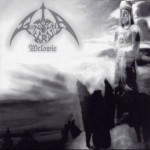
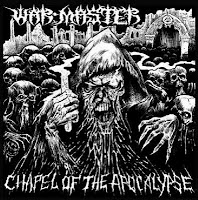
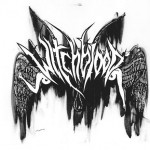
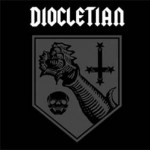
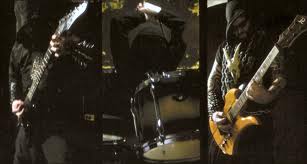 Structurally, the songs of Diocletian adhere to the musical formulas that define
Structurally, the songs of Diocletian adhere to the musical formulas that define  Most would think that a bassist is an indispensable component of any metal band; Inquisition disagree. Far from the average live band, these two Columbians consider themselves quite adequate at performing between themselves, minus a bassist, despite their reliance on a strong rhythm section, something which was notably present during their ‘ritual’. The music of Inquisition is fairly straightforward, with a steady, pulsing rhythm occasionally giving space for an eerie melody to shine through the tempest; it is simple, almost formulaic, but the key timing and the pure quality of the melodies are what really gives life to the compositions. Anyway, the most important thing for Inquisition to accomplish in the live setting is to invoke a real sense of the ritual, to make manifest the strong feeling of darkness prevalent throughout their post-thrash metal albums. With an identifiable aura of black villainy (achieved using only the scarcest amount of corpse paint), and with a loud, flawless manipulation of their respective instruments (irrespective of the audience’s cries of ‘get a bassist!’), Dagon and Incubus succeeded in demonstrating the nocturnal power of their music through the medium of stage, conquering any doubts that might have been made along the way. On a more personal note, I was most pleased to hear a favourite of mine played, namely, ‘
Most would think that a bassist is an indispensable component of any metal band; Inquisition disagree. Far from the average live band, these two Columbians consider themselves quite adequate at performing between themselves, minus a bassist, despite their reliance on a strong rhythm section, something which was notably present during their ‘ritual’. The music of Inquisition is fairly straightforward, with a steady, pulsing rhythm occasionally giving space for an eerie melody to shine through the tempest; it is simple, almost formulaic, but the key timing and the pure quality of the melodies are what really gives life to the compositions. Anyway, the most important thing for Inquisition to accomplish in the live setting is to invoke a real sense of the ritual, to make manifest the strong feeling of darkness prevalent throughout their post-thrash metal albums. With an identifiable aura of black villainy (achieved using only the scarcest amount of corpse paint), and with a loud, flawless manipulation of their respective instruments (irrespective of the audience’s cries of ‘get a bassist!’), Dagon and Incubus succeeded in demonstrating the nocturnal power of their music through the medium of stage, conquering any doubts that might have been made along the way. On a more personal note, I was most pleased to hear a favourite of mine played, namely, ‘
 On first listen some would easily assume that this release were a mere product of nostalgia of underground metal of the 1980′s, at least indicated so by the production and indication that are present here. However this is death/speed/black metal firmly rooted in the underground
On first listen some would easily assume that this release were a mere product of nostalgia of underground metal of the 1980′s, at least indicated so by the production and indication that are present here. However this is death/speed/black metal firmly rooted in the underground 